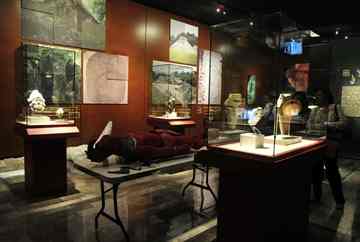The goods found in graves of six leaders of the classic period of Maya culture (AD 200-900), which had been distributed to various museums after the exploration of their graves, now recover their original meaning in an exhibition that opened Thursday in the Mexican capital.
 A total of 147 parts originating in southern Mexico make up the exhibition "Faces of divinity. The Mayan jade mosaic," the first exhibition that offers a complete reading of "the historic and symbolic values that characterize these offerings," said curator Sofia Martinez del Campo.
A total of 147 parts originating in southern Mexico make up the exhibition "Faces of divinity. The Mayan jade mosaic," the first exhibition that offers a complete reading of "the historic and symbolic values that characterize these offerings," said curator Sofia Martinez del Campo.
The capital's National Museum of Anthropology and History commemorates the ceremonies "with deep ritual symbolism" honored Maya rulers as if they were divine beings, "said the expert.
These goods were for King Pakal, whose tomb has always been considered one of the most important archaeological finds in Mexico, and six other dignitaries whose names are not known.
The goods come mostly from archaeological sites in Palenque (Chiapas), Calakmul (Campeche), Dzibanché (Quintana Roo) and Oxkintok (Yucatan).
K'inich Janaab' Pakal (23 March 603 - 28 August 683) was ruler of the Maya polity of Palenque in the Late Classic period of pre-Columbian Mesoamerican chronology. During a long reign of some 68 years Pakal was responsible for the construction or extension of some of Palenque's most notable surviving inscriptions and monumental architecture.
Pakal ascended the throne at age 12 on July 29, 615, and lived to the age of 80. The name pakal means "shield" in the Maya language.
Pakal saw expansion of Palenque's power in the western part of the Maya states, and initiated a building program at his capital that produced some of Maya civilization's finest art and architecture.
He was preceded as ruler of Palenque by his mother Lady Sak K'uk'. As the Palenque dynasty seems to have had Queens only when there was no eligible male heir, Sak K'uk' transferred rulership to her son upon his official maturity.
After his death, Pakal was succeeded by his son Chan Bahlum II. A younger son, Kan Xul II, succeeded his brother Chan Bahlum II.
Source: Art Daily [August 16, 2010]